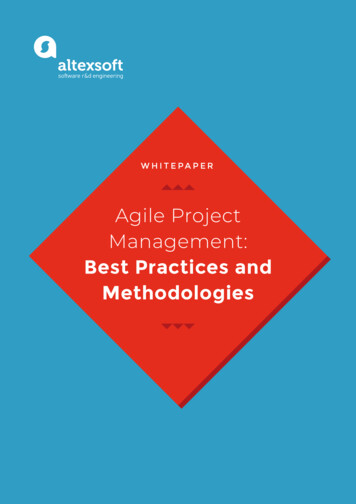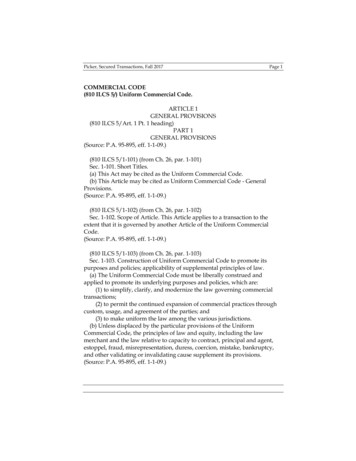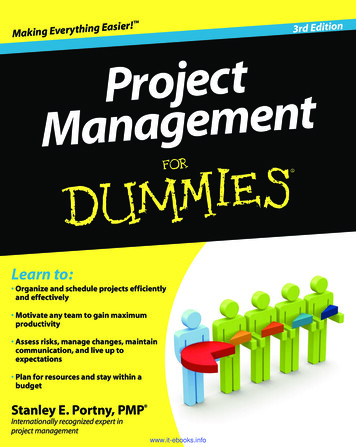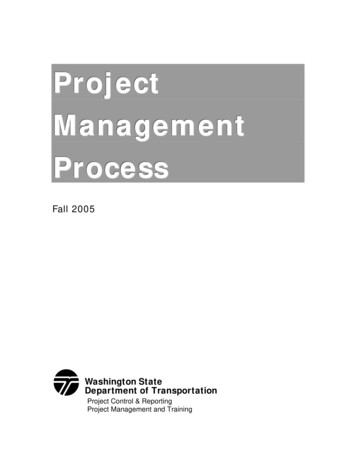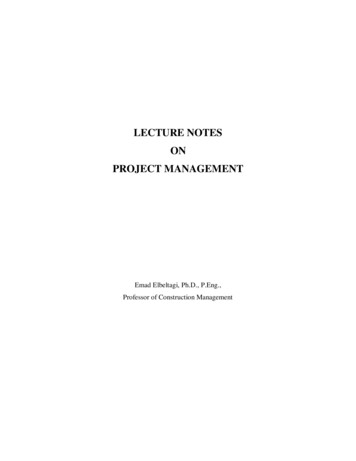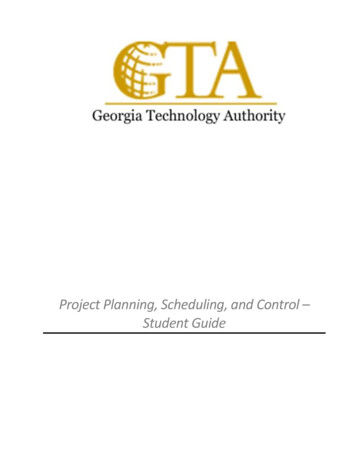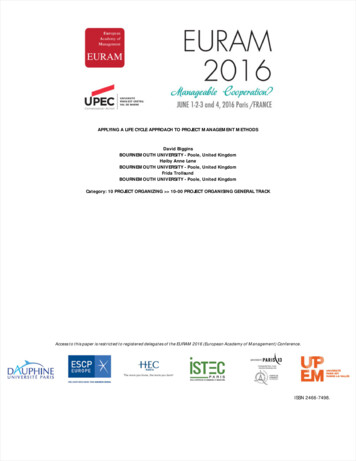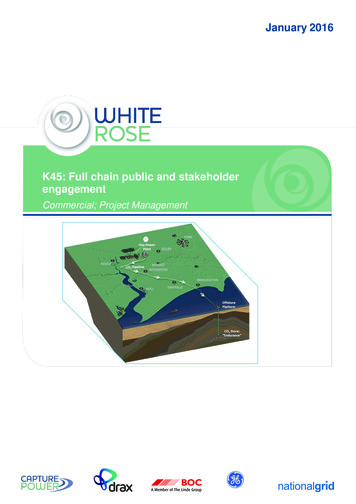
Transcription
January 2016K45: Full chain public and stakeholderengagementCommercial; Project Management
K45: Full chain public and stakeholder engagementIMPORTANT NOTICEThe information provided further to UK CCS Commercialisation Programme (the Competition) set out herein (the Information) hasbeen prepared by Capture Power Limited and its sub-contractors (the Consortium) solely for the Department of Energy andClimate Change in connection with the Competition. The Information does not amount to advice on CCS technology or any CCSengineering, commercial, financial, regulatory, legal or other solutions on which any reliance should be placed. Accordingly, nomember of the Consortium makes (and the UK Government does not make) any representation, warranty or undertaking, expressor implied, as to the accuracy, adequacy or completeness of any of the Information and no reliance may be placed on theInformation. In so far as permitted by law, no member of the Consortium or any company in the same group as any member of th eConsortium or their respective officers, employees or agents accepts (and the UK Government does not accept) any responsibilityor liability of any kind, whether for negligence or any other reason, for any damage or loss arising from any use of or any r elianceplaced on the Information or any subsequent communication of the Information. Each person to whom the Information is madeavailable must make their own independent assessment of the Information after making such investigation and taking profession altechnical, engineering, commercial, regulatory, financial, legal or other advice, as they deem necessary.The contents of this report draw on work partly funded under the EuropeanUnion’s European Energy Programme for Recovery. The European Union isnot responsible for any use that may be made of the information containedwithin this document.
K45: Full chain public and stakeholder engagementContentsChapterTitlePageExecutive Summaryi1Introduction11.11.21.3Background 1White Rose CCS (Generating Station) DCO 1Yorkshire and Humber Cross Country Pipeline DCO 12White Rose CCS (Generating Station) DCO32.12.22.32.42.5The Background to the ProjectThe ApplicantThe Project SiteThe ProjectSummary of Stakeholder Processes344593Legislative Context and Compliance3.13.1.13.1.2Legislative Context 12Overview of the DCO Regime 12Legislative Requirements for Pre-application Consultation and Publicity 134The Applicants approach to Consultation164.14.24.34.44.5Consultation objectivesConsultation best practice Advice and GuidanceDefinition of the Consultation areaConsultation process and methodsRecording, Analysing and Responding to Consultation16161719215Non-Statutory Consultation235.15.25.35.45.55.6Who was consulted?How were they consulted?What were they consulted upon/what information was provided?When did the consultation take placeHow could feedback be providedResponse to the consultation2323242425256Statutory consultation: identifying consultees266.16.26.36.46.56.66.7Section 42 “Duty to consult”Section 42(a) – Such persons as may be prescribedSection 42(b) – Each local authority that is within S.43Section 42(d) – Each person in one or more of the categories set out in Section 44Non-prescribed consulteesSection 47 “Duty to consult local community”Section 48 “Duty to publicise”262627272929307Section 47: Preparation of the Statement of Community Consultation317.1Background to the preparation of the SoCC 31The contents of this report draw on work partly funded under the EuropeanUnion’s European Energy Programme for Recovery. The European Union isnot responsible for any use that may be made of the information containedwithin this document.12
K45: Full chain public and stakeholder engagement7.27.37.4Statutory consultation on the Draft SoCC 32Non-statutory consultation on a revised Draft SoCC 33Publication of the SoCC Notice and final SoCC 348Section 47: Duty to Consult Local 8.48.4.18.4.28.58.5.18.5.28.68.6.18.6.28.7Who was consulted?Stage 1Stage 2How were they consulted?Stage 1Stage 2What were they consulted upon/what information was provided?Stage 1Stage 2When did the consultation take place/deadlines for responsesStage 1Stage 2How could feedback be providedStage 1Stage 2Response to the consultationStage 1Stage 2Compliance with the SoCC353535363637383838393940414141414142439Section 42: Duty to Consult459.19.29.39.49.59.6Who was consulted?How were they consulted?What were they consulted upon/what information was provided?When did the consultation take place/deadlines for responsesHow could feedback be provided?Response to the consultation45454647484810Section 46: Duty to Notify Secretary of State of Proposed Application4911Section 48: Duty to Publicise5112EIA related Consultation5412.112.212.312.412.5EIA Notification and Scoping – Regulations 6(1) and 8(1)EIA Transboundary Effects – Regulation 24Approach to Preparation and Publication of Preliminary Environmental InformationEIA Regulation 11 NotificationPreparation and Finalisation of the ES545555565613Section 49: Duty to take account of responses to Consultation and Publicity5713.1Summary 5814Other Consultation and EngagementThe contents of this report draw on work partly funded under the EuropeanUnion’s European Energy Programme for Recovery. The European Union isnot responsible for any use that may be made of the information containedwithin this document.60
K45: Full chain public and stakeholder engagement14.114.214.314.4PINS ConsultationLocal Community and political representativesLocal Authorities and Technical ConsulteesExamination phase6060616115Yorkshire and Humber Cross Country Pipeline DCO6415.115.2Background 64Scope 6416Purpose6617Project Definition and Study Area6717.117.217.3Project Definition 67Geographical Context 68Timeline 6918Legislation and Guidance that have Influenced Stakeholder Engagement7419Social Site Characterisation 19.619.7Approach to Stakeholder MappingObjectivesSocial Site CharacterisationSources of informationOverview of public and stakeholder engagementInformation SourcesStages of ConsultationProject Issues AppraisalResponses Appraisal: Outcomes and Project ChangesProject StakeholdersLegislative Requirements767778787878808182828420Approach of .320.4.420.4.520.4.620.4.720.520.6Team StructureEngagement Strategy and PlansGenerating the Consultation Strategies and the Statement of Community Consultation (SoCC)Engagement StrategyMessaging and Engagement MaterialsConsultationsStage 1 ConsultationPost Stage 1 engagementStage 1A ConsultationStage 2 ConsultationStage 2A ConsultationStage 2B ConsultationStatutory ConsultationThe Consultation Report858585858787878989919496979721Key Learning for Knowledge Transfer98The contents of this report draw on work partly funded under the EuropeanUnion’s European Energy Programme for Recovery. The European Union isnot responsible for any use that may be made of the information containedwithin this document.
K45: Full chain public and stakeholder engagement22Summary of Conclusions and Recommendations10023Glossary103AppendicesAppendix AAppendix BAppendix CAppendix DAppendix E108OPP Public Exhibition Display BoardsOPP Public Exhibition Workshop PresentationOPP Stakeholder Mapping ReportOPP Finalised Statement of Community ConsultationNGCL public consultation materialThe contents of this report draw on work partly funded under the EuropeanUnion’s European Energy Programme for Recovery. The European Union isnot responsible for any use that may be made of the information containedwithin this document.109122124151157
K45: Full chain public and stakeholder engagementList of TablesTableTitleTable 3.1Legislative Requirements for Pre-application Consultation and PublicityTable 4.1Consultation Methods and ActivitiesTable 8.1Stage 1 Public ExhibitionsTable 8.2Stage 2 Public ExhibitionsTable 8.3Compliance with the SoCCTable 9.1Section 42 Consultation Dates and PeriodsSection 46 Notification DatesTable 10.1Table 11.1Table 12.1Newspapers used for first Section48 NoticeTable 13.1Changes to the Project/ApplicationTable 14.1PINS ConsultationTable 16.1Deliverables IndexTable 17.1NGCL Timeline Stakeholder EngagementTable 19.1Engagement MeansTable 19.2Feedback from Consultations and other Stakeholder Engagement ActivitiesTable 20.1Consultation CalendarTable 20.2Stage 1 Advertisement Placement CalendarTable 20.3Stage 1A Advertisement Placement CalendarTable 20.4Stage 2 Advertisement Placement CalendarTable 22.1Summary of ConclusionsTable 22.2Summary of RecommendationsConsultation with Technical Consultees on Draft ES ChaptersList of FiguresFigureFigure 4.1TitlePublic Consultation ZonesFigure 17.1CO2 Transport and Storage SystemFigure 20.1Carbon Dioxide – familiar uses and simple experimentsThe contents of this report draw on work partly funded under the EuropeanUnion’s European Energy Programme for Recovery. The European Union isnot responsible for any use that may be made of the information containedwithin this document.
K45: Full chain public and stakeholder engagementKey WordsKey WordMeaning or ExplanationBiomassWood chips used in combustionCarbonAn element, but used as shorthand for its gaseous oxide, CO2.CaptureCollection of CO2 from power station combustion process or other facilities and itsprocess ready for transportation.StorageContainment in suitable pervious rock formations located under impervious rockformations usually under the sea bed.TransportRemoving processed CO2 by pipeline from the capture and process unit to storage.StakeholderPersons and organisations who/which have a vested, direct or indirect interest in ora genuine concern for all or part of the proposed project.EngagementEngagement describes the myriad of ways in which the planning of the proposedproject might be shared with the stakeholders. Engagement is by definition a twoway process, involving interaction and listening, with the goal of generating mutualbenefit and understanding.The contents of this report draw on work partly funded under the EuropeanUnion’s European Energy Programme for Recovery. The European Union isnot responsible for any use that may be made of the information containedwithin this document.
K45: Full chain public and stakeholder engagementExecutive SummaryThe Full Chain Public and Stakeholder Engagement report was generated as part of theFront End Engineering Design (FEED) contract with the Department of Energy andClimate Change (DECC) for White Rose, an integrated full-chain Carbon Capture andStorage (CCS) Project. This document is one of a series of Key Knowledge Deliverables(KKD) from White Rose to be issued by DECC for public information. This report drawson work, which was undertaken by Capture Power Limited (CPL) for the Oxy PowerPlant (OPP) White Rose CCS (Generating Station) Development Consent Order (DCO)and by National Grid Carbon Limited (NGC), as part of its promotion of the Yorkshire andHumber CCS Cross Country Pipeline DCO. The work undertaken by NGC is partlyfunded under the European Union’s European Energy Programme for Recovery (EEPR).White Rose comprises a new coal-fired ultra-supercritical OPP of up to 448 MWe (gross)and a Transport and Storage (T&S) network that will take the carbon dioxide from theOPP and transport it by pipeline for permanent storage under the southern North Sea.The OPP captures around 90% of the carbon dioxide emissions and has the option toco-fire biomass.Delivery of the project is through CPL, an industrial consortium formed by GeneralElectric (GE), BOC and Drax, and NGC, a wholly owned subsidiary of National Grid.This report sets out the process by which CPL and NGC identified the key stakeholdersrelevant to the White Rose CCS (Generating Station) and the Yorkshire and HumberCCS Cross Country Pipeline respectively, including MPs, MEPs, county councillors,district / unitary councillors and relevant officers, parish councillors, environmental andlocal interest groups and community organisations. This included a comprehensiveidentification process in the very early stages of the development of the project, withongoing reviews and updates to ensure that all relevant stakeholders and otherinterested parties were part of the consultation process.Extensive stakeholder consultation took place throughout the development of theprojects up to the submission of their DCO applications. This early and extensiveconsultation helped to ensure that stakeholders were able to play a role in the shapingand development of the project. The consultation programme featured two rounds ofnon-statutory consultations, known as the Stage 1 Consultation and the Stage 1AConsultation, followed by one round of statutory consultation, which was the Stage 2Consultation.The contents of this report draw on work partly funded under the EuropeanUnion’s European Energy Programme for Recovery. The European Union isnot responsible for any use that may be made of the information containedwithin this document.i
K45: Full chain public and stakeholder engagementStakeholders were contacted in a number of ways, including letters, advertisements, theproject website, meetings and public exhibitions. This was to ensure that CPL and NGCengaged with as many stakeholders as possible throughout the project.In addition, the language used in these communications was accessible to all. It wasimportant that CPL and NGC didn’t just provide information on the project and theplanning process, but also on CCS as a technology and the value of implementing CCS,further information can be found in a joint study by the TUC and the Carbon Capture andStorage Association (CCSA) ncapturebenefits.pdf and in the socioeconomic chapter of the Environmental Impact Assessment (EIA) on-capture-and-storageproject/?ipcsection docs&stage app&filter Environmental Statement . The Yorkshireand Humber region has a large amount of power generating technology and as such isthe perfect place to create a CCS network. CPL and NGC did a lot of work withstakeholders who were not directly affected by the project but could be involved in anexpansion of CCS. It is worth noting that due to the infrastructure heavy economy in thisarea and the opinion that CCS will benefit the local economy many councils and MPswere keen to see CCS expanded.This report outlines what CPL and NGC did to ensure its community engagement wasthorough and provides further information on local stakeholders which will be of benefit toother project promoters.Her Majesty’s Government (HMG) Spending Review was set out on 25 November 2015outlining its capital budget and priorities. A market announcement on the same dayindicated that the 1 billion ring-fenced capital budget for the Carbon Capture andStorage Competition was no longer available, the Spending Review accordingly did notinclude such budget. This meant that the Competition could not proceed as originallyenvisaged. Following this decision, a notice of termination was issued on 23 December2015 under the White Rose FEED Contract, which terminated accordingly on 25 January2016, prior to the expected completion date of FEED. The Government and CPL arecommitted to sharing the knowledge from UK CCS projects, and this Key KnowledgeDeliverable represents the learning achieved up to the cancellation of the CCSCompetition and termination of the FEED Contract and therefore does not necessarilyrepresent the final and completed constructible project.The contents of this report draw on work partly funded under the EuropeanUnion’s European Energy Programme for Recovery. The European Union isnot responsible for any use that may be made of the information containedwithin this document.ii
K45: Full chain public and stakeholder engagement1Introduction1.1BackgroundThe White Rose Carbon Capture and Storage (CCS) Project (WhiteRose) is an integrated full-chain CCS project comprising a new coalfired Oxy Power Plant (OPP) and a transport and storage (T&S)network that will take the carbon dioxide (CO2) from the OPP andtransport it by pipeline for permanent storage under the southern NorthSea.The OPP is a new ultra-supercritical power plant with Oxyfueltechnology of up to 448 MWe gross output that will capture around 90%of CO2 emissions and also have the option to co-fire biomass.One of the first large scale demonstration plants of its type in the world,White Rose aims to prove CCS technology at commercial scale as acompetitive form of low-carbon power generation and as an importanttechnology in tackling climate change. The OPP will generate enoughlow carbon electricity to supply the equivalent needs of over 630,000homes.White Rose is being developed by CPL, a consortium of GeneralElectric (GE), BOC and Drax. The project will also establish a CO 2transportation and storage network in the region through the Yorkshireand Humber CCS pipeline being developed by National Grid CarbonLtd (NGCL).1.2White Rose CCS (Generating Station) DCOCPL will provide the OPP element of the project. The OPP includes allelements on a conventional coal fired power station plus additionalelements necessary to achieve CCS.The conventional power plant includes the boiler, turbine hall, powergeneration and transformers, Air Quality and Control Systems (AQCS).The CCS elements include an Air Separation Unit (ASU) and a GasProcessing Unit (GPU) for purification and compression of CO2. Inaddition to these elements the OPP includes a cooling water facility andinterconnections with the existing Drax site.1.3Yorkshire and Humber Cross Country Pipeline DCONational Grid will provide the transportation and storage element of theproject. This includes the transportation pipeline and pressure boostingfacilities; offshore CO2 reception and processing facilities, and injectionwells into an offshore storage reservoir.The contents of this report draw on work partly funded under the EuropeanUnion’s European Energy Programme for Recovery. The European Union isnot responsible for any use that may be made of the information containedwithin this document.1
K45: Full chain public and stakeholder engagementThe transportation and storage elements of the White Rose CCSProject comprise two elements: the “Onshore Scheme”, which includesthe construction of a Cross Country Pipeline (including the AboveGround Installations (AGIs) such as Pipeline Internal Gauge Traps, amulti-junction, it’s block valve sites and an onshore pumping station) totransport CO2, in dense phase from electricity generation and industrialcapture plants in the region and the “Offshore Scheme” which includesan offshore pipeline to transport the CO2 to a permanent storage sitebeneath the North Sea. The Onshore and Offshore Schemes arelocated, sized and designed to accommodate CO2 emissions capturedfrom multiple sources; although an initial, direct connection which theWhite Rose CCS Project power station itself forms the primary focus ofthe Front End Engineering Design (FEED) Contract.The Onshore Scheme requires a new buried high pressure crosscountry pipeline of approximately 67km in length with an externaldiameter of 610mm for the transportation of the dense phase CO2 to alocation on the Holderness coast. The Offshore Scheme requires anew high pressure 90km sub-sea pipeline to a geological storage site.The storage site presently proposed is a saline aquifer locatedapproximately 1000m below the seabed. The Onshore and OffshoreSchemes would be joined at the Mean Low Water Mark usingappropriate landfall techniques. The Onshore Scheme is a NationallySignificant Infrastructure Project (NSIP) under the Planning Act 2008and hence is subject to the grant of a Development Consent Order(DCO). The Offshore Scheme is subject to a separate consentingprocedure under the Petroleum Act 1998 and the Energy Act 2008 andhas been subject to a separate application.The contents of this report draw on work partly funded under the EuropeanUnion’s European Energy Programme for Recovery. The European Union isnot responsible for any use that may be made of the information containedwithin this document.2
K45: Full chain public and stakeholder engagement2White Rose CCS (Generating Station)DCOCPL (the Applicant) is seeking a DCO to authorise the construction,operation and maintenance of a new thermal generating station (anultra-supercritical oxy-fuel coal-fired power plant of up to 448megawatts (MWe) gross with the ability to co-fire biomass) that will befitted with CCS technology and associated development (together theProject) on land within and adjacent to the existing Drax Power Stationsite, Drax, near Selby, North Yorkshire, YO8 8PH, within theadministrative areas of Selby District Council (Selby DC) and NYCC.The Project falls within the definition and thresholds for a NSIP underSections 14 and 15(2) of the 2008 Act. It is therefore necessary forCPL to apply to the Secretary of State (SoS) for DECC for‘Development Consent’ for the Project under Section 31 of the 2008Act.The DCO, if made, would be known as the ‘White Rose CCS(Generating Station) Order’ (the Order). A draft of the Order forms partof the Application and sets out the authorisations and powers that theApplicant is seeking in respect of the Project.It is important to note that with NSIP projects that differ in type andscale, such as between CPL’s Generating Station and National Grid’sYorkshire and Humber CCS Cross Country Pipeline development,differences can result between the projects in terms of the consultationexercise undertaken. With a project such as CPL’s Generating Station,the location is next to an existing power station where the localpopulation is broadly supportive of a major employer in the region onland which is owned by Drax. With National Grid’s Yorkshire andHumber CCS Cross Country Pipeline, the linear nature of the projectmeans that more people may be affected by or indeed interested in theproject in terms of the project’s eventual land take, compulsory orotherwise. Many more people will have been involved in theconsultation process prior to submission of the application.The DCO documents are available to view online on the PINS on-capture-and-storageproject/?ipcsection docs&stage app&filter Reports2.1The Background to the ProjectThe Project would support the development of the CO2 pipeline (theYorkshire and Humber CCS cross-country CO2 pipeline) currently beingpromoted by NGCL within the Yorkshire and Humber region, totransport CO2 for permanent storage beneath the North Sea ingeological structures. It is understood that the CO2 pipeline would beThe contents of this report draw on work partly funded under the EuropeanUnion’s European Energy Programme for Recovery. The European Union isnot responsible for any use that may be made of the information containedwithin this document.3
K45: Full chain public and stakeholder engagementused by other power generators and industrial operators in the region.The CO2 pipeline and associated storage are being advancedseparately by NGCL (who submitted an application for a DCO to theSoS in 2014) and they do not form part of the Generating StationProject.2.2The ApplicantSince its inception in 2010, the Project has been promoted by aconsortium comprising Drax and GE, with BOC joining in 2011.CPL is an English private limited company that was incorporated inDecember 2011 as a fully owned subsidiary of Drax CCS Limited (acompany fully owned by Drax Group plc). In December 2013 ALSTOMUK Holdings Limited (a GE company) and The BOC Group Limited (aLinde Group company) each acquired a one-third interest in CPL. CPLis therefore currently a joint venture company equally owned by DraxCCS Limited, ALSTOM UK Holdings Limited and The BOC GroupLimited.CPL is able to draw upon the significant experience that exists withinthe joint venture companies in relation to power generation, CCStechnology and engineering, amongst other capabilities. Furtherinformation on the joint venture companies can be found on the Projectwebsite: www.whiteroseccs.co.uk2.3The Project SiteThe Project Site (the Order Limits) comprises land within and adjacentto the boundary of the existing Drax Power Station site. The RiverOuse is located to the north and north-east, with the Barlow Mound(used for the long-term storage of fuel ash from Drax Power Stationbeing situated to the north and east. The existing Power Station site islocated to the south.The Project site includes land within the operational boundary of theexisting Power Station site and part of the Barlow Mound. However,the bulk is located outside and adjacent to the northern boundary of theexisting Power Station site.The entire Project site extends to just over 116 hectares (ha), of whichapproximately 29 ha would be a permanent operational area. Thetemporary laydown and construction areas extend to approximately 39ha, with the remaining areas (required primarily for variousThe contents of this report draw on work partly funded under the EuropeanUnion’s European Energy Programme for Recovery. The European Union isnot responsible for any use that may be made of the information containedwithin this document.4
K45: Full chain public and stakeholder engagementinfrastructure connections and for the most part within the existingPower Station site) totalling approximately 49 ha.The Project site (with the exception of areas within the existing PowerStation site and at the Barlow Mound) comprises land used inconnection with Drax Power Station and low-lying agricultural land,interspersed with a series of drainage ditches.Further details of the project site can be found in the documents on thePINS website.2.4The ProjectAs confirmed above, the Project comprises a new thermal generatingstation with a nominal gross electrical output capacity of up to 448 MWegross, fitted with CCS technology and associated development. TheProject would have the capacity to provide sufficient electricity for630,000 households, while capturing two million tonnes of CO2 perannum arising from the combustion process (up to 90% of emissions).Schedule 1 of the draft Order provides the formal description of theProject and the components for which Development Consent is sought,and identifies the individual ‘Works Numbers (Works Nos.)’ for thesecomponents.The Works Plans identify the location and extent of the components ofthe Project within the Project site by reference to the Works Nos. setout in Schedule 1 of the draft Order.The main components of the Project (with reference to the relevantWorks Nos.) can be summarised as follows:Work No. 1A and 1B - site raising and preparation works to create adevelopment platform for the generating station to an appropriate levelto mitigate flood risk, for the creation of bridges and crossings over theCarr Dyke and for site access works, site raising and hardstandings forthe laydown and construction areas; Work No. 1A - a generating station (the coal-fired power plant)located in the northern part of the Project site, to the north ofthe existing Power Station site, primarily fuelled by coal, butwith the ability to co-fire biomass, that will be capable ofgenerating up to 448 MWe gross of electricity, including a boilerhouse, steam turbine, cooling water towers, flue gas treatmentThe contents of this report draw on work partly funded under the EuropeanUnion’s European Energy Programme for Recovery. The European Union isnot responsible for any use that may be made of the information containedwithin this document.5
K45: Full chain public and stakeholder engagement systems, a flue gas emissions stack, air separation units andCO2, processing and compression facilities;Work No. 1B - laydown and construction areas for constructionand maintenance;Work No. 2 - fuel intake, limestone and gypsum and fuel ash handlingand transportation infrastructure, including connections with the existingPower Station site (located broadly along the western side of theProject site and existing Power Station site) for the delivery of fuel andlimestone for the combustion and flue gas desulphurisation processes,and for the export of fuel ash for storage at the existing Barlow Moundand also for the transport of gypsum;Work No. 3 - fuel ash storage on part of the existing Barlow Moundforming the north-western part of the Project site located to the northwest of the existing Power Station site;Work No. 4 - a primarily underground connection to the electricity gridwhich would comprise a 400kV cable and associated infrastructurerunning along the eastern side of the Project site to the existingsubstation located in the south-eastern part of the existing PowerStation site;Work No. 5 - connections for cooling water, potable water andsewerage, and related facilities between t
K45: Full chain public and stakeholder engagement The contents of this report draw on work partly funded under the European Union's European Energy Programme for Recovery. The European Union is not responsible for any use that may be made of the information contained within this document. Chapter Title Page Executive Summary i 1 Introduction 1

